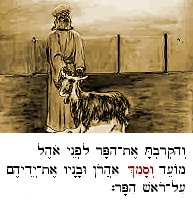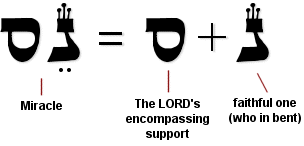|
|
 |
|
|
 |
 |
 |
|
- The Meaning of Samekh
The root of the word Samekh  means "to lean upon," "to uphold," or "to support." The root is also found in the Jewish concept of semikhah, the laying on of hands upon the head of a sacrificial victim in a blood ritual of the Jewish Temple, which was also a means of consecrating the priesthood (Lev 8; Exodus 29, etc.). Biblical references to the root occur in Lev 16:21, Deut 34:9, Ezekiel 24:2, and elsewhere. In ancient times, Samekh may have represented a shield. Today, the Jewish Rabbinical ordination ceremony is called a semikhah. means "to lean upon," "to uphold," or "to support." The root is also found in the Jewish concept of semikhah, the laying on of hands upon the head of a sacrificial victim in a blood ritual of the Jewish Temple, which was also a means of consecrating the priesthood (Lev 8; Exodus 29, etc.). Biblical references to the root occur in Lev 16:21, Deut 34:9, Ezekiel 24:2, and elsewhere. In ancient times, Samekh may have represented a shield. Today, the Jewish Rabbinical ordination ceremony is called a semikhah.

Then you shall bring the bull before the tent of meeting. Aaron and his sons shall lay (samakh) their hands on the head of the bull. Exodus 29:10
- The Mystery of Samekh
According to the Chaz'l (sages), Samekh is said to represent the endless and ever-ascending spiral of God's glory in the universe. This cycle is hinted at in the divine  (seder) of creation, and is revealed in both the seasons and in the rhythm of the Jewish mo'deim (festivals). (seder) of creation, and is revealed in both the seasons and in the rhythm of the Jewish mo'deim (festivals).

Samekh is also the letter for Sukkah, indicating that God's omnipresence is our support and shelter. God is active in His support for creation (Hebrews 1:3), and we are passive in relying our trusting in His provision and care for our lives.
- Samekh and the Priestly Blessing
The letter Samekh represents the number 60, and some of the Jewish sages have noted that this is the same number of letters found in the Birkat Kohanim - the "Priestly Blessing" found in Numbers 6:23-27.

Also of note is the fact that the Priestly Blessing's 60 letters are used to form 15 words - the same ordinal number that represents the letter Samekh. Notice that the Gematria for the word "Samekh" is 120 (Samekh+Mem+Kaf), which represents the double portion of blessing given in both the former covenant and the newer covenant of Yeshua.
- The Gematria of Samekh
The letter Samekh is represented as Yod - Hey in the Hebrew numbering system, which is also one of the Sacred Names of God.

- The Miracle of Samekh
The letter Nun, which immediately precedes the letter Samekh in the alphabet, suggests someone who is "bent," or someone who humbles himself in brokenness and submission to the LORD God. Putting these two letters together, we have the Hebrew word nes, miracle.

A person of faith is a walking miracle! The LORD gives support to the fallen and broken ones who put their trust in Him. Indeed, this is directly illustrated in Psalm 145, an acrostic Psalm that begins it's verse about Samekh as follows:
|
|















